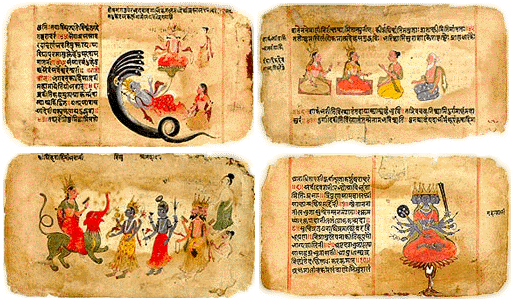Day 1 - A bit of Yoga Vocabulary and Philosophical Context - Vedas and Darshans - #30 Days Yoga Challenge

Today I want to share a few notes about the philosophy and the bigger system or context in which Yoga appeared so we can understand better what it really means when we talk about it.
In the Indian culture there are the Vedas and the Upanishads.
Etymologically “vid” means “to know”, “veda” means “knowledge, wisdom”.
In the Hinduism tradition it is said that the Brahman (The Creator) imparted the divine knowledge to the sages - called Rishis - who disseminated it to the people through the Vedas.
The Samhitas (Sanskrit saṃhitā, "collection"), are collections of metric texts ("mantras"). There are four "Vedic" Samhitas: the Rig-Veda, Sama-Veda, Yajur-Veda, and Atharva-Veda, most of which are available in several recensions (śākhā). In some contexts, the term Veda is used to refer to these Samhitas. You can read more details about the Vedas on the Wiki page here
The first Vedas date back to 1700- 1100 B.C. and there are so many that nobody knows all of them. And because there are so many Vedas people started to study them, following certain points of view.
Thus appeared the “Darshans”. In Sanskrit, "darshan" means "point of view".
There are 6 systems or Darshans considered orthodox in the Hindu tradition.
NYAYA - reffers to rules, logic, method
VAISESHIKA - believes that only the perception and the inference from evidence and reason are reliable means of valid knowledge
SANKHYA - metaphysical dualism based on two entities Prakrti and Purusha or Nature and Soul. It provides the metaphysical infrastructure for yoga
YOGA - a system of techniques and practices that aim to attain a state where consciousness is unware of any object external to itself, to help you understand what your Soul is so you become free from pain and suffering.
PURVA MIMASA - supports the law of karma and believes in an Unseen Power or “apurva”
UTARA MIMASA or VEDANTA - gives strong attention to the concept of Dharma which means virtue, morality, duty, proper duty or proper way to act.
What's the point of all these systems? Why do they exist?
Ultimately, all these systems try to reveal, to help us understand the relationship between Brahman/God/Ultimate Reality - Atman (Soul) - World. And Yoga is a method that helps the Soul become aware of itself.
So now you have a glimpse at what Yoga really means and is part of, which is way more than what we, in the Western part of world are aware of.
That’s it for today, I hope you enjoyed the short introduction to the Yoga vocabulary .
I'll see you tomorrow with more insights surrounding the Yoga philosophy and practice.
If you liked this post give it an upvote/resteem, I will highly appreciate it. :)
Image source Veda Wikidot

@raluca Well done for sticking at it! Followed.
Thank you!
I've tried yoga and it feels so good and relaxing.
I think there's a small mistake in this post, Brahma is the Creator(God of Creations) while Brahman is his creation (in this case, the universe).
Finally some really relevant yogic content. Followed!
Thank you!